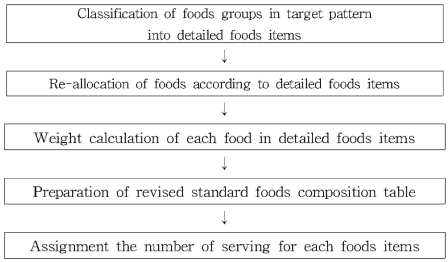Korean J Community Nutr.
2014 Jun;19(3):274-282. 10.5720/kjcn.2014.19.3.274.
Revision and Application of the Target Pattern in Food Guidance System: Administered to 2nd grade middle school students
- Affiliations
-
- 1Department of Home Economics, Korea National University of Education, Chungwon-gun, Korea. youngnam@knue.ac.kr
- KMID: 2268067
- DOI: http://doi.org/10.5720/kjcn.2014.19.3.274
Abstract
OBJECTIVES
The objective of this study was to revise the target pattern in food guidance system for adolescents' balanced menu planning.
METHODS
The food groups in the target pattern were divided into detailed food items, and intake number were assigned to each food items based on the revised standard food composition table. The validity of revised target pattern was examined. Menu planning according to the revised target pattern was made available to 305 male and female middle school students and the nutritional assessment of the menu plan were carried out using SPSS WIN 12.0.
RESULTS
The energy contents, energy contribution ratios of carbohydrate, fat, and protein, and 4 minerals' and 6 vitamins' contents of the revised target pattern were adequate. The average energy contents of the menu planned according to revised target pattern were 400~500 kcal higher than that of the revised target pattern when the revised standard food composition was applied. The energy contribution ratios of fat were 28.9%, close to maximum of acceptable macronutrient distribution range (AMDR) (30%), and that of carbohydrate were 54.5%, lower than minimum of AMDR (55%). The nutrient adequacy ratios (NARs) of calcium and vitamin C were less than 1.0. According to index of nutritional quality (INQ) of food items, kimchi, milkdairy products, and soybean curd were energy efficient source for calcium, kimchi, fruit, vegetable and seaweed were energy efficient source for vitamin C, with INQ of food items were higher or close to 2.0. Kimchi was the best energy efficient source of calcium and vitamin C.
CONCLUSIONS
Revised target pattern based on the adolescent's foods intake was not good enough for balanced menu planning by adolescents, because what they ate and what they wanted to eat were very much different. Detailed guidance for food selection is necessary in each food items.
Keyword
MeSH Terms
Figure
Cited by 2 articles
-
Development of a Food Exchange Table and Food Pattern for Nutritionally Balanced Menu Planning
Yun Ahn, Ikhyun Yeo, Sangyun Lee, Kisun Nam
Korean J Community Nutr. 2018;23(5):411-423. doi: 10.5720/kjcn.2018.23.5.411.Designing optimized food intake patterns for Korean adults using linear programming (I): analysis of data from the 2010~2014 Korea National Health and Nutrition Examination Survey
Kana Asano, Hongsuk Yang, Youngmi Lee, Jihyun Yoon
J Nutr Health. 2018;51(1):73-86. doi: 10.4163/jnh.2018.51.1.73.
Reference
-
1. Gibson RS. Principles of nutritional assessment. New York, Oxford: Oxford University Press;1990. p. 143–145.2. Han SS, Kim HY, Kim WK, Oh SY, Won HS, Lee HS, Jang YA, Kim SH. The relationships among household characteristics, nutrient intake status and academic achievements of primary, middle and high school students. Korean J Nutr. 1999; 32(6):691–704.3. Kim AR, Kim MJ, Kim YN. Nutritional assessment of menu plan prepared according to the target pattern: Menu prepared by home economics teachers and middle-school girls. Korean J Community Nutr. 2011; 16(3):375–385.4. Kim JO, Kim YN. Assessment of menu plan prepared by middle school students according to ordinary meal pattern and single serving size. Korean J Community Nutr. 2013; 18(4):333–343.5. Kim SH, Kang BN. Worldwide dietary life and food culture. Seoul: Daewnagsa;2007. p. 166–169.6. Kim YS, Kim BR. A study on nutrition knowledge, dietary behaviors and evaluation of nutrient intakes of high school female students in Chuncheon area by frequency of breakfast. J Korean Home Econ Educ Assoc. 2012; 24(4):91–104.7. Koo JO, Lim HS, Yoon JS, Lee AR, Lee JH. Understanding basic nutrition. Seoul: Powerbook;2012. p. 17–30. p. 210–212.8. Lee SC. Relationship between the dietary habits of middle school girls and their personality and school grades. Korea National University of Education;2004. 73–74. Dissertation.9. Ministry of Health & Welfare, Korea Centers for Desease Control & Prevention. Korea Health Statistics 2011: Korea National Health and Nutrition Examination Survey (KNHANES V-2). Cheongwon: 2012. cited May 1, 2013. Available from https://knhanes.cdc.go.kr/knhanes/index.do.10. The Korean Nutrition Society. Dietary refernce intakes for Koreans. 1st revision. Seoul: 2010. p. 4–6. p. 524–535.
- Full Text Links
- Actions
-
Cited
- CITED
-
- Close
- Share
- Similar articles
-
- Comparison of Dietary Attitudes and Attitudes to the School Lunch Service of Elementary and Middle School Students Living in the Same Region
- The Physical Development and Dietary Intake for Korean Children and Adolescents: Food and Nutrient Intake
- Comparisons of Food Preference and Nutrient Intake of Students of Elementary School and Middle School Providing School Food Service in Nam Jeju Gun
- Test-retest Reliability of a Self-Administered Smoking Questionnaire for Middle and High School Students
- The Study on Dietary Behaviors of Elementary School Student in Chungnam Area According to the School Food Service Type, Gender and Grade


